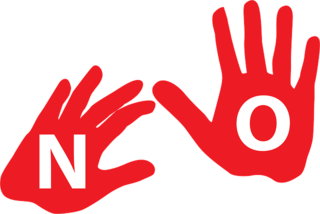
When we encounter anxiety or fear, our natural response is to try to get rid of it. Which is why so many people turn to anti-anxiety drugs or antidepressants to take the edge off. Though these drugs can be helpful in the short-run, say when you are going through a particularly stressful time, they are not a fix. They can lead to dependence and troubling side effects. Moreover, taking a pill doesn’t solve your problems or teach you any new skills or behaviors. At best they merely cover over your problems. Consequently, it's not surprising that cognitive-behavioral therapy (CBT) has become the go-to treatment for anxiety and fear, as it is designed to help people acquire skills they can use to manage these and other troubling emotions.
One skill I use with patients is just saying NO to anxiety and fear. This doesn’t mean trying to force yourself not to feel anxious or fearful when you are feeling anxious or fearful. It means owning up to your feelings, but not letting them take over your life. Saying “NO” means “No, I’m not going to let anxiety ruin my day or keep me from living my life.” Like spitting in the wind, trying to fight off anxiety can backfire, as focusing attention on it only makes it more salient or stronger. Anxiety and fear are hard-wired emotional reactions to perceptions of threat. The threat can be physical, as in the case of your car hitting an ice patch and veering out of control, or when you hear suspicious noises downstairs in the middle of the night. Or it can be psychological, as when you take an important exam, give a public speech or make a presentation, or interact with others at a party or on a date. When anxiety or fear is disproportional to the threat and impacts your ability to function, such as when you become so fearful of taking an elevator that you turn down a job interview for a desirable job because the company is located on a high floor, it may rise to the level of a diagnosable anxiety disorder.
With anxiety disorder patients, we can often trace the origins of the problem to traumatic or fearful experiences with particular types of stimuli or situations. We can then design a program of exposures to the very things that give the person the willies and help equip them with coping skills they can use to manage these situations more effectively.
One of these skills is learning to say NO.
- NO . . . to Fighting Anxiety. Let negative emotions such as fear or anxiety just pass through your body. Don’t fight them off. Bear in mind you can’t directly control your emotions. Emotions are your body’s way of signaling you to pay attention. Read the signal. Anxiety signals that you perceive an immediate threat or danger. Tell yourself, “Okay, I’m anxious (or afraid). This just means that I’m sensing a threat. I’m probably just overreacting.” Talk calmly to yourself and let the anxiety just pass through your body. Anxiety is just an uncomfortable emotional state; it has no power over you. Tell yourself, “Okay I’m anxious. But it’s not going to kill me. I’ve dealt with this before and I can deal with it again. It’ll pass. Give it time.”
- NO . . . to Self-Defeating Thoughts. Rather than say to yourself, “OMG, I’m not going to be able to deal with this. This is too much,” take a step back and coolly, dispassionately examine your body’s reactions as though you were studying them in a laboratory. Try saying something to yourself like, “I’m getting those feelings again. My breathing is heavier and my hands are getting shaky. It’s no big deal. It’s just anxiety. It’ll pass.” Visualize it flowing right through your body, starting from the top of your head and moving down your body, passing right through your toes and out of your body. Study it as though you were watching it from a distance.
- NO . . . to Anxiety Holding You Back. I’ve treated patients for various types of phobias, from fear of heights to fear of riding on elevators, to fear of flying, fear of social interactions or social phobia, and in a most unusual case, to fear of signing one’s name in public (a rare form of social phobia). Typically, the physical features of anxiety (the shakiness, the rapid heart rate and breathing, and yes, the nervous sweating) is slower to change than the behavioral features of anxiety and fear (avoidance of the feared object or situation). In other words, following a series of real-life exposures to confronting feared objects or situations, a person with an elevator phobia may be able to use an elevator, but report shaking the whole time. Generally speaking, it takes longer for the body to catch up and learn to relax.
One patient, a 38-year old woman, suffered from a fear of driving over elevated roadways. She made good progress in her exposure trials, finally reaching the top of her hierarchy, driving across a stretch of high road near her home. Surprisingly, when she finally accomplished her goal, she was anything but pleased with herself. She reported to me in therapy the next week that she felt like a failure. This faulty way of thinking---snatching defeat from the jaws of victory---resulted from her measuring progress based on what she was feeling, rather than what she was doing. I pointed out to her that she had succeeded in accomplishing a task that had stymied her for years and that with repeated practice, the body would adjust as the habit became more routine. Before long, she was driving across elevated roadways without even a glimmer of fear. Which brings us to the point of saying "NO" to anxiety keeping us on the sidelines. When facing anxiety or fear, try saying to yourself, “I’m feeling nervous, but I don’t have to curl up in a ball waiting for it to pass. It’s okay to be jittery but get on with things. So what if I’m anxious? It’s annoying, but it’s not going to kill me. It’s uncomfortable, but it doesn’t need to hold me back.”
- Saying NO. . . to Get to YES. Say no to anxiety and then yes to a distracting activity, especially one to calm yourself down. “No, I’m not going to let anxiety get to me. Yes, I’ll just practice my deep breathing exercise.” On other blogs in this series I shared some coping skills my patients have found helpful in coping with anxiety. They have used common distracters such as listening to comedy tapes, reading a favorite book, going to the gym, or even playing backgammon. One patient I treated for fear of flying made a game of counting the different colored shirts and blouses fellow passengers were wearing—how many were black, red, and so on. When you distract yourself from the perceived threat, the anxiety or fear may begin to fade.
Saying “No” is self-affirming. It conveys you are in control, not the anxiety or fear. You may not be able to directly control your emotions by sheer force of will, but you can control how you respond to negative emotions and take back control.
Note. The blog entries on the Minute Therapist are intended for informational purposes and not for diagnosis, evaluation, or treatment of mental health disorders. If you are concerned about your emotional well-being or are experiencing any significant mental health problems, I encourage you to consult a licensed mental health professional in your area for a thorough evaluation.
© 2018 Jeffrey S. Nevid


